Care & Use of Appliances
Proper care and use of orthodontic appliances is critical to both the effectiveness of the treatment and the amount of treatment time. Below is a list of various orthodontic appliances.

Proper care and use of orthodontic appliances is critical to both the effectiveness of the treatment and the amount of treatment time. Below is a list of various orthodontic appliances.
A bite plate is a removable appliance similar to a retainer that is used to correct a deep bite or to help correct a crossbite.
You have received a bite plate to help straighten your teeth. Your bite plate is an active orthodontic appliance and needs to be worn continuously. Your bite plate won’t work if you only wear it at night. That’s because continuous pressure must be maintained in order to move teeth; otherwise they will move the right way while you wear your bite plate and the wrong way when you have it out. Your bite plate should be worn as close to 24 hours a day as is possible, including while eating. It should only be removed while you brush your teeth and when playing contact sports that require a mouthguard. The rest of the time, it must be fully seated in your mouth.
When you need to take your bite plate out of your mouth, you must keep it in the case we supplied. Many appliances have been accidentally thrown away, stepped on or chewed by a dog because they were left sitting out. NEVER wrap your bite plate in a napkin, as it could be accidentally thrown away or broken.
DO NOT clean you bite plate in hot water, DO NOT boil or microwave it and DO NOT leave it sitting in the sun, even if it is in its case. Excessive heat will warp the plastic and ruin it.
To clean your bite plate, scrub it with a toothbrush and toothpaste, making sure to clean both sides of the plastic. You may soak it in retainer or denture cleaning solutions if desired.
DO NOT chew gum while your bite plate is in your mouth.
When you start wearing your bite plate, your teeth and gums may get sore or tender. This is normal and expected. Soreness of the teeth should go away within one week – if you wear your bite plate faithfully. If you take it out every time your teeth get tender, you will never get used to it. If you have a persistent area of tenderness on your gums, please call for an adjustment appointment. If anything happens to your bite plate – it gets lost, broken, distorted, warped or anything else, let us know as soon as possible.
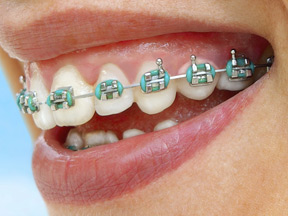 Every day, please check that you do not have any loose braces by gently trying to slide each one (usually when brushing your teeth at night). If a wire or brace comes loose, do not be alarmed. If a tie wire is protruding and irritating, use a blunt instrument (back of a spoon or a pencil eraser) and carefully push the wire out of the way. If you have a loose or broken appliance, please call us and we will make the appropriate arrangements to adjust or repair it. If a piece comes loose, save it and bring it with you to the office.
Every day, please check that you do not have any loose braces by gently trying to slide each one (usually when brushing your teeth at night). If a wire or brace comes loose, do not be alarmed. If a tie wire is protruding and irritating, use a blunt instrument (back of a spoon or a pencil eraser) and carefully push the wire out of the way. If you have a loose or broken appliance, please call us and we will make the appropriate arrangements to adjust or repair it. If a piece comes loose, save it and bring it with you to the office.
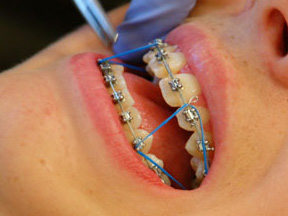 Elastics are essentially rubber bands that are used during the appropriate stage of orthodontic treatment to apply tension, which causes teeth to move in the desired direction. They are attached by the patient as directed to specific brackets, usually between the upper and lower front or back teeth. They can be used in many ways depending on the treatment goals established.
Elastics are essentially rubber bands that are used during the appropriate stage of orthodontic treatment to apply tension, which causes teeth to move in the desired direction. They are attached by the patient as directed to specific brackets, usually between the upper and lower front or back teeth. They can be used in many ways depending on the treatment goals established.
Elastics move the teeth in directions that cannot be accomplished with braces alone. Your teeth and jaws may be tender during the first few days of wearing the elastics. This is normal and the tenderness should begin to disappear within a week. If it persists longer, please call our office. Rinsing with warm salt water will help relieve the tenderness.
Elastics may seem difficult to put on at first, but this will become easier with practice. You may remove the elastics only when eating your meals or brushing your teeth. Leave them in when you are snacking. Be sure to replace the elastics with new ones at least every 24 hours. Part-time wear does NOT move teeth but it can cause them to be constantly sore.
Carry extra elastics with you at all times. If you don’t have enough to last until your next appointment, please stop by our office and pick up more or call us and we can mail them to you. We don’t want you to run out.
Before you leave the office, be absolutely sure you understand exactly where to hook the elastics. Placing them incorrectly can result in extending your time in treatment. If you ever have any questions about how to wear your elastics, please do not hesitate to ask.
Elastic wear is important in helping to determine the speed of your treatment, as well as the final results. Please call us if you have any questions or concerns. Good luck with your elastics!
 Now that your treatment has been completed and appliances have been removed, you should schedule a cleaning and checkup appointment with your dentist. Retainers support your teeth in their corrected positions and guide them into the established occlusion. Failure to wear your retainers as instructed may cause a rapid relapse; therefore, observe the following instructions:
Now that your treatment has been completed and appliances have been removed, you should schedule a cleaning and checkup appointment with your dentist. Retainers support your teeth in their corrected positions and guide them into the established occlusion. Failure to wear your retainers as instructed may cause a rapid relapse; therefore, observe the following instructions:
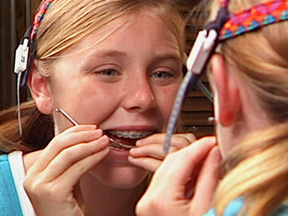 You have been given a headgear. It is a very important part of your orthodontic treatment. The more you wear it, the faster we can correct your overbite. If you choose not to wear it as instructed, it won’t work and your teeth won’t move properly! We know you want to have better looking teeth. Wearing your headgear is something you can do to help things along.
You have been given a headgear. It is a very important part of your orthodontic treatment. The more you wear it, the faster we can correct your overbite. If you choose not to wear it as instructed, it won’t work and your teeth won’t move properly! We know you want to have better looking teeth. Wearing your headgear is something you can do to help things along.
Your headgear will make your teeth sore for about 4-7 days after you start wearing it. As long as you keep wearing it every night, the soreness will disappear. Don’t worry if it doesn’t make your teeth sore – it is still working. Be very careful when placing and removing your headgear. Always release the pressure on the sides before placing and removing it. Bring the arms downward and away from your face and never upward toward your eyes!
When headgear is prescribed:
When wearing headgear, expect:
At each appointment in our office:
If you think you have a problem with your headgear, call our office right away. We will schedule an appointment and make any adjustments that are needed.
 Now that your treatment has been completed and appliances have been removed, you should schedule a cleaning and checkup appointment with your dentist. Considerable time and effort is needed to make new ones and there is a replacement charge to do so. Retainers support the teeth in their corrected positions and guide them into the established occlusion. Failure to wear the retainers, even for a short time, may cause a rapid relapse; therefore, observe the following instructions:
Now that your treatment has been completed and appliances have been removed, you should schedule a cleaning and checkup appointment with your dentist. Considerable time and effort is needed to make new ones and there is a replacement charge to do so. Retainers support the teeth in their corrected positions and guide them into the established occlusion. Failure to wear the retainers, even for a short time, may cause a rapid relapse; therefore, observe the following instructions:
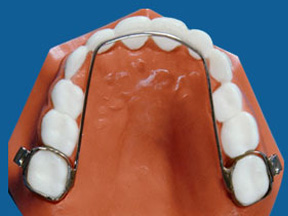 The lingual arch is a fixed appliance that is banded around the molars. It is used to hold space for developing permanent teeth when baby teeth are lost or extracted prematurely. It also prevents the molars from moving forward, which could cause crowding.
The lingual arch is a fixed appliance that is banded around the molars. It is used to hold space for developing permanent teeth when baby teeth are lost or extracted prematurely. It also prevents the molars from moving forward, which could cause crowding.
Please try to leave the wire alone as much as you can. After you have it for a while, you will likely forget that it is even there. At first, you may find the bands or the wire somewhat irritating to your tongue. It should not feel sharp, and you should not develop any sores on your tongue or gums. If you do, let us know right away so we can adjust your appliance.
The front teeth and sometimes the teeth with the bands around them may get sore and tender the day after we insert the wire for the first time. If this happens, you can take an over-the-counter pain reliever (such as Tylenol or Motrin) as directed. The soreness will disappear within a few days. With this appliance in your mouth, you will be restricted from eating certain foods. Do not eat anything sticky, chewy, very hard or crunchy, like gum, caramels, taffy, Gummy Bears, beef jerky, ice, nuts, hard candies, popcorn, etc. These foods can loosen the bands from your teeth or bend the wire.
Do not pull up on the front of the wire with your fingers or tongue. If you do, the wire could bend out of shape and may not work properly. If food gets down between the wire and your teeth and you are having trouble getting it out, don’t pull the wire away from your teeth. Use your toothbrush to clean between the wire and teeth.
Call our office if:
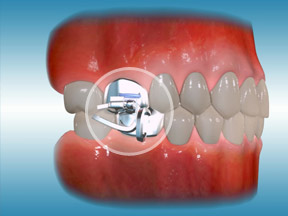 The Mara is an appliance that helps posture your jaw forward when you bite down. This helps correct overbites in growing patients. Usually, it is worn about 9-12 months before removal. After the first week of wear, it should be comfortable. In order to make your first week go smoothly, here are a few hints:
The Mara is an appliance that helps posture your jaw forward when you bite down. This helps correct overbites in growing patients. Usually, it is worn about 9-12 months before removal. After the first week of wear, it should be comfortable. In order to make your first week go smoothly, here are a few hints:
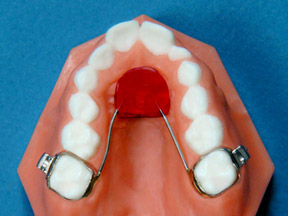 The Nance holding arch is generally worn to maintain space in the upper arch until the permanent teeth erupt.
The Nance holding arch is generally worn to maintain space in the upper arch until the permanent teeth erupt.
You must avoid eating certain foods when the appliance is in your mouth. Do not eat anything sticky, chewy, very hard or crunchy like gum, caramels, taffy, Gummy Bears, beef jerky, ice, nuts, hard candies, popcorn, etc. These foods can loosen the bands from your teeth or bend the wire.
Brush your teeth as usual, paying attention to the bands that hold the appliance in. Brush gently along the gum line to remove the plaque and then brush the wire and plastic pad in the roof of your mouth. Extra brushing is important. Brush often, after eating and at bedtime.
Call our office for an appointment if:
 This expander is for patients with a narrow upper jaw. It gently widens the upper arch (palate) by stretching the center palatal connective suture. Once widened, the suture knits together. This expander is prescribed only prior to completion of growth. A parent or the patient adjusts the expander daily as instructed, until the palate has been widened enough. It is then left in place for about six months without further adjustment while new bone fills the center palatal suture.
This expander is for patients with a narrow upper jaw. It gently widens the upper arch (palate) by stretching the center palatal connective suture. Once widened, the suture knits together. This expander is prescribed only prior to completion of growth. A parent or the patient adjusts the expander daily as instructed, until the palate has been widened enough. It is then left in place for about six months without further adjustment while new bone fills the center palatal suture.
Before the expander feels comfortable, you may sense some initial pressure and expect:
A special key is used to activate the expander:
Since your appliance is cemented in, brush it as you would your teeth, paying attention to the bands that hold it in. Brush gently along the gum line to remove the plaque. Brush after eating and at bedtime.
Call our office for an appointment if:
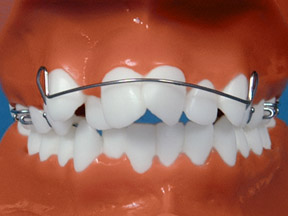 The Schwarz appliance is a removable functional appliance which expands the dental arch forms and can be used to correct crossbites, enlarge narrow dental arches and upright teeth that are tipped inward. It is normally activated weekly by the patient (or parent) and then adjusted by Dr. Hallgren at monthly intervals in our office.
The Schwarz appliance is a removable functional appliance which expands the dental arch forms and can be used to correct crossbites, enlarge narrow dental arches and upright teeth that are tipped inward. It is normally activated weekly by the patient (or parent) and then adjusted by Dr. Hallgren at monthly intervals in our office.
The Schwarz you are now wearing is delicate and must be handled with care when out of the mouth. It took a great deal of time and careful work to construct it. PLEASE take care! Breakage will result in added expense.
Your Schwarz must be worn at all times except when cleaning it. You must, therefore, eat and sleep with the appliance in your mouth and keep it in throughout the day. It should be left out ONLY while engaging in contact sports, swimming in lakes and brushing your teeth.
Eating and speaking may be mildly different the first few days. You are advised to eat soft foods such as eggs, cereals and soups. However, within a few days normal foods can be eaten and with a little practice, all words pronounced. You should avoid sticky or very hard foods which could loosen or damage your appliances.
When you brush your teeth after every meal, brush your appliances with your toothbrush and toothpaste. Do NOT use extremely hot water when cleaning. You may soak them in retainer or denture cleaning tablets if desired. Replace your appliances immediately after rinsing.
A special key is used to activate the Schwarz appliance. Insert the key into its slot and push it in the direction of the indicator arrow until it stops. Remove the key. You will notice that a new slot is now visible which you will use for the next activation (one week later). You will be instructed as to when you will no longer need to activate your appliance.
It’s quite common for some teeth to feel sore during the first few days; this tenderness should disappear after the initial adjustment period. Should it continue beyond three to five days – or should irritation of the gums, cheeks, lips or tongue persist, or should a wire be accidentally bent – do not attempt to adjust the appliance yourself. Call for an appointment.
Without cooperation there can be little, if any, improvement. With good cooperation, one can achieve the maximum results in the minimum amount of time.
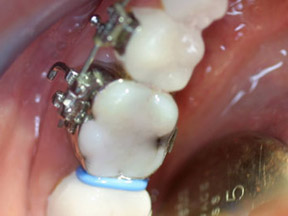 Separators (spacers) are small rubber bands, or occasionally wires, that go in-between your teeth to make room for orthodontic bands if they are needed during your treatment. It is very important that the separators stay in place until you come back to get your bands on. There are some things you need to do to make sure they stay in.
Separators (spacers) are small rubber bands, or occasionally wires, that go in-between your teeth to make room for orthodontic bands if they are needed during your treatment. It is very important that the separators stay in place until you come back to get your bands on. There are some things you need to do to make sure they stay in.
Brush your teeth as you normally do; a Waterpik should be fine if you normally use one. Initially, some people notice soreness in the areas where the separators are present due to the pressure they put on the teeth. Feel free to take an over-the-counter pain reliever such as Tylenol or Motrin as needed during this short period of initial discomfort. However, most people have no difficulty with the separators. They will be removed when your bands are placed.
If separators should fall out:.
If you are unable to replace a separator that has come out, or if one is accidentally lost, please call our office and we will be happy to schedule an appointment to replace it for you.
The spring retainer is an appliance that can be used on both arches. It is great for minor rotation and correction of anterior alignment. Spring retainers are used most often in cases involving minor tooth shifting due to loss of retainers or lack of retainer wear following the completion of orthodontic treatment.
Your spring retainer won’t work if you only wear it at night. That is because in order to move teeth there needs to be continuous pressure on them; otherwise they will move the right way while you wear your spring retainer and the wrong way when you have it out. Your spring retainer needs to be worn as close to 24 hours a day as possible. It is ok to remove it while you eat, while you brush your teeth and while you play sports. The rest of the time it must be fully seated in your mouth.
When you need to take your spring retainer out of your mouth, you must keep it in the case that we gave you. Many appliances have been accidentally thrown away, stepped on or chewed up by the dog because they were left sitting out. NEVER wrap your spring retainer in a napkin while you eat. Always have your case with you. If you don’t have your case available, don’t take out your spring retainer. Leave it in your mouth while you eat and rinse it off afterwards.
Caring for Your Spring Retainer
 The twin block appliance is made up of upper and lower acrylic “plates” that work together to correct the bite. One fits the upper jaw and the other fits the lower jaw, and together, they bring the lower jaw forward.
The twin block appliance is made up of upper and lower acrylic “plates” that work together to correct the bite. One fits the upper jaw and the other fits the lower jaw, and together, they bring the lower jaw forward.
The appliances you are now wearing are delicate and must be handled with care when out of the mouth. It took a great deal of time and careful work to construct them. PLEASE take care! Breakage will necessitate added expense.
Your appliances must be worn at all times except when cleaning them. You must, therefore, eat and sleep with the appliances in your mouth and keep them in throughout the day. They should be left out ONLY while engaging in contact sports, swimming in lakes and brushing your teeth.
Eating and speaking may be mildly different the first few days. You are advised to eat soft foods such as yogurt, eggs, cereals and soups. However, within a few days normal foods can be eaten and with a little practice, all words pronounced. You should avoid sticky or very hard foods which could loosen or damage your appliances.
When you brush your teeth after every meal, brush your appliances with your toothbrush and toothpaste. Do NOT use extremely hot water when cleaning. You may soak them in retainer or denture cleaning tablets if desired. Replace your appliances immediately after rinsing.
It is common for some teeth to be sore during the first few days. This tenderness should disappear after the initial adjustment period. However, should it continue beyond three to five days – or should irritation of the gums, cheeks, lips or tongue persist, or should a wire be accidentally bent – do not attempt to adjust it yourself. Instead, call for an appointment.
Without cooperation, there can be little, if any, improvement. With good cooperation, one can achieve the maximum results in the minimum amount of time.